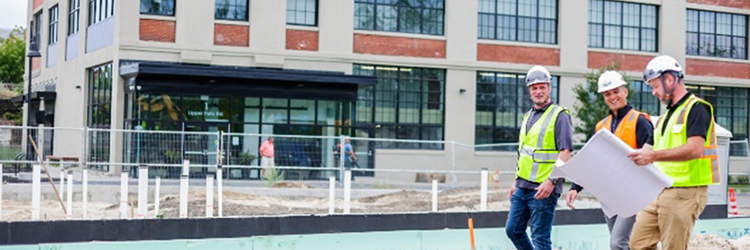Remember the good ‘ole days of long inventory lists and property tours? When will they return to Southern Maine? - by Justin Lamontagne

The year was 2011, and a young, ambitious broker received a lead on a 30,000 s/f industrial tenant in search of a simple warehouse with a few overhead doors and a loading dock. The broker swiftly compiled an inventory of seven or eight attractive options in the Greater Portland area and scheduled a property tour. Three months later, after some healthy negotiations and back-and-forth, a new lease was executed, leaving everyone satisfied with the experience and end-result.
Fast forward to today, the same broker with an identical requirement, cautiously explains to their tenant-client that the overall vacancy rate in Greater Portland is an unthinkable 0.66%. The inventory list and tour schedule are so limited that it now includes raw land, office buildings, and properties 30 miles from the preferred location. The tenant can’t believe there are no options for them to grow in Southern Maine, leading them to ask the broker for referrals out of state.
This dramatic anecdote is becoming all too common in today’s industrial sector. In simple terms, the lack of industrial supply in Southern Maine is detrimental to our economy. Analyzing this year’s Southern Maine industrial market survey results, it’s shocking to note that of the 19 million s/f in Greater Portland, a mere 125,000 s/f is vacant. Even with sublet opportunities adding another 112,000 s/f, the total available rate is a paltry 1.25%.
Expanding the geography of this year’s report to other parts of Southern Maine revealed that the supply/demand imbalance permeates throughout the region from York County to Androscoggin. Only Lewiston, among the 15 towns and cities, has what could be considered a “healthy” industrial market, where tenants might have some leverage. However, even there, the numbers are somewhat misleading, with virtually all inventory accounted for by five to six very large empty buildings. Indeed, a recent survey in Lewiston for a 7,000 s/f industrial client uncovered exactly one suitable option, proving their reported 10%+- vacancy rate is deceivingly high.
So, what’s an industrial business to do? While new construction and land development remain options, they are costly and time-consuming endeavors. Therefore, I predict we’ll see more creative repurposing of office and retail spaces. This trend has already begun with some small success stories. And in 2024 we will have no choice but to consider if the interiors of empty office buildings or retail buildings can be gutted and otherwise retrofitted to accommodate industrial end-users. This concept’s success will depend on several factors falling into place, not the least of which is zoning. But for lower-impact tenants not requiring traditional taller ceilings and multiple loading docks, a single-story office building could serve as a decent warehouse with the right modifications.
Not surprisingly, industrial values, both for sale and lease, continue to appreciate dramatically. For the first time, average sale prices have surpassed $100 per s/f, reaching $104 based on over 25 industrial sales in the Greater Portland area. Smaller buildings under 10,000 s/f regularly see prices at or above $150 per s/f, equaling replacement value. This proves that the often complicated and slow process of new construction is deterring end-users. And it further indicates that “shovel-ready” industrial land sites like the Innovation District at Scarborough Downs are the most successful model.
Lease prices are also on the rise, though not as dramatically as sale values. A 3% increase was calculated in 2023, but I anticipate a more significant increase in 2024. Most listed spaces on the market are now asking well above $10 s/f NNN, reaching as high as $13-14 s/f for smaller units, surpassing rates for class B and low-A office spaces in many cases. This has led to sticker shock for industrial tenants, especially those new to the market or accustomed to years of rates near $5-6 per s/f. This push-back from tenants is partially accounting for the slower pace in lease rate increases. Unfortunately for them, basic supply and demand economic principles will usurp any heartburn tenants have looking at their real estate budgets.
My crystal ball isn’t insightful enough to project how to fix this problem. All I can do is identify the critical issue and hope that conditions improve for our local industrial businesses. And I can always fondly reminisce about the good ‘ole days of long inventory lists and property tours.
Justin Lamontagne, CCIM, SIOR is a partner | designated broker with The Dunham Group, Portland, ME.
Reveler Development celebrates final phase of work at The Levee - new 51-unit apartment building in Biddeford


Interest rates and inflation - by Matthew Bacon
As we all know, interest rates have been changing drastically, with movement in both directions, depending on the type and term of financing. The Federal Open Market Committee has taken drastic action in efforts to curb abnormally high inflation, but it hasn’t controlled labor cost growth to the extent that was intended.

Maine multifamily outlook: Opportunities in Portland, Bangor, and Lewiston-Auburn - Blake Wright and Kristie Russell
The multifamily market in Maine’s major cities presents a diverse range of opportunities for investors. We looked at the potential benefits and unique characteristics of three major submarkets in the state: Portland, Bangor, and Lewiston-Auburn. The information below is based on research done in CoStar and county registries, and focuses on multifamily properties that have four or more units.

Residential is here to untie the office space doom loop - by Thomas House


 (1) (1).png)





.png)


.png)